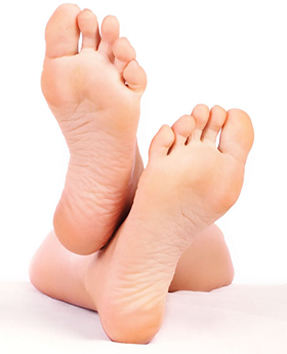Cracked heels are very common. They can be painful, unattractive, and very upsetting – especially to those of us who love sandals.
Cracked heels are a sign of lack of attention to foot care rather than just overexposure or lack of moisturizing. Medically, cracked heels are also known as heel fissures. Fissures are regular linear cut wounds and mostly affect the surface level which comprises of the epidermis. Sometimes it may get deep into the dermis and become painful. Excessive pressure on the feet pads make the feet want to expand sideways. As the skin, surrounding the sides of the feet are dry they crack and cause cracked heels. Appearances of cracked heels also indicate zinc and omega-3 fatty acid deficiency.
Though cracks in the skin may arise anywhere in the body the most common is area is the rim of the heel and web of toes, which happen to be the most frequently or constantly used parts of our body. Dry skin or xerosis is one of the most common causes that lead to cracked heels .The other key reason being thick or callus skin around the rim of the heel. Most of the foot problems arise due to neglect and oversight with regard to feet care. Cracked feet, corns and other common feet ailments can be attended to and are easily avoidable.
Cracked heels are not a harmful in anyway except when the fissures or cracks are deep, and tend to become painful and the skin begins to bleed. This could lead to infection and is an avoidable situation mostly for those already suffering from chronic ailments such as diabetes or lowering immune system due to age or illness which may retard the treatment of cracked heels.
Cracked heels are a common occurrence for senior citizens or people who are constantly on their feet thus exerting pressure on the feet pad. It can affect either both the heels or one of the heel. But most commonly, cracked heels affect both the feet.
Usually, cracked skin on our heels and feet is caused by excessively dry skin. For many it’s worse in the winter months or for those who live in dry climates. But going barefoot and wearing shoes with open backs can exaserbate the problem, meaning that even in the summer our feet are in rough shape.
Unfortunately, as the condition worsens, it becomes more difficult to treat, since regular moisturizers won’t penetrate the dry, dead, thick skin on our heels.
It’s important to note that skin problems on our feet can be a sign of other health issues, and particularly people with diabetes, skin or circulation problems will want to discuss any foot care regimen with their doctor before beginning. If the cracks on your heels are very deep or bleeding, you’ll also want to speak with your doctor.
If like most of us, you’re just suffering from worn and weathered skin, here is the routine I used to recently combat a very bad case of very dry and cracked skin on my heels.
Most common symptoms of dry, cracked heels and feet
Signs and symptoms that surface on the skin are simple indicators of a faulty internal activity or an external abuse. If one observes the body and its manifestations minutely one can avoid disease and disorders by treating them before they take on a destructive path. Similarly, feet care calls for a little attention and when the feet finds it lacking they indicate the following signs to show the feet could do well with some care.
The most common symptoms of dry, cracked heels and feet include:
-Red or flaky patches
-Peeling and cracked skin
-Itchy skin
-Bleeding or discharge from cracks
Consume a diet rich in calcium, iron, zinc and omega-3 fats
Cracked heels are caused by deficiency of vitamins, minerals, zinc and omega 3 fatty acids. Therefore it is essential to have a diet rich in vitamins, minerals and zinc. Omega-3 fatty acids are not naturally produced by the body, therefore it has to be ingested from food or supplements.
Here is list of essential foods that one can include in a regular meal and help curb deficiencies that may cause cracked heels:
-Vitamins (Vitamin E) rich foods include: vegetable oils, green vegetables, cereals, wheat germ, whole-grain products and nuts.
-Minerals (Calcium and Iron) rich foods include :
1) Calcium: milk, cheese, yogurt, goat’s milk, fortified soya milk, mineral water, ice cream, tinned fish, juices, cereals and broccoli are excellent sources of calcium. Dairy products such as milk and yogurt are also considered as one of the best sources of calcium.
2) Iron: Meat, chicken and fish are good sources of iron. Iron is also available in cereals, eggs, vegetables and beans; however it is not as easily absorbed into the body as the iron from meat, chicken and fish.
3) Zinc rich foods include: Oysters, chicken, crab, kidney beans, yogurt, brown rice, spaghetti.
4) Omega-3 fatty acids are largely found in: Purslane herb, cold water fish, and flaxseed oil or flax seeds.



Very interesting blog post thank you for sharing I have added your site to my favorites and will check back 🙂 By the way this is a little off topic but I really like your sites layout.